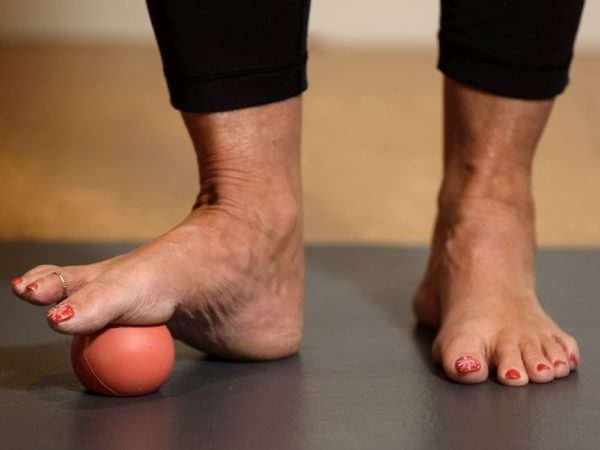
Helen Vanderburg poses with a massage ball at Heavens elevated fitness on Friday, January 17, 2020. Azin Ghaffari/Postmedia Azin Ghaffari / Azin Ghaffari/Postmedia
Have you ever considered what your feet need to endure daily? We rarely give them any attention, yet they will carry us many miles throughout our lives.
The feet are like the foundation of a building. If the foundation is weak, it seriously affects the structure it holds. Therefore, we need to exercise the feet regularly to keep this structure strong.
The foot is a very complex structure: with 23 bones, 33 joints and more than 100 muscles, tendons and ligaments, the foot needs some love. The structure of the foot is designed to take a load, transfer forces through the body and be highly adaptable to the environment. This allows us to walk, run, dance and jump. The sole is the first interaction we have to the ground. The sensory nerves of the foot constantly gather information regarding terrain, pressure and temperature. This collection of data happens without us thinking about it. Patterns are formed and the feet adapt to the environment. The actual structure of the foot may change dramatically based on whether you spend time barefoot on the beach or in boots in the snow. Along with these environmental differences, the sensitivity of our feet to our environments will alter.
Training your feet and ankles should be a part of your regular fitness regime. Shoes can limit the range of motion and sensitivity of your feet. This is the case for barefoot training and minimalist shoes for fitness endeavors versus highly supportive shoes. But remember you need to walk before you run. In other words, if you need supportive shoes based on your work environments, foot structure or injuries, think progression and transition when it comes to building stronger functional feet.
The first step is to get familiar with your feet. You can do a simple observation or have a professional access your foot and ankle alignment. On bare feet, observe how you stand. Where do you naturally put the weight? Do you weigh to the outside or inside of the foot? Do you lean forward into the ball of the foot or to the heel? Next, observe how you walk when barefoot. Do your foot and ankle feel stiff or does the foot roll from heel to toe easily?
Add foot mobility and strengthening exercises to your daily routine. Start by spending some time barefoot to allow the foot and ankle to go through a full range of motion. Walking barefoot will enhance mobility, sensitivity, and strength. Progress from stiff shoes to barefoot depending on your comfort level.
Perform specific foot exercises to enhance function. Try passive toe spreading. In a seated position, lift one foot and bring the one hand under the foot and weave the fingers between the toes. Essentially spread the toes out. Hold this and move the foot and ankle in various motions such as pointing the toes or flexing the ankle.
Perform toe spreading exercises without the use of your hands by picking up the toes off the floor while standing or seated the spreading the toes to create space between each toe. Next, work the muscles of the toes and feet by lifting and lowering the big toes only. Then lifting and lowering the fours toes.
Massage the foot with a small massage ball or tennis ball. In a standing or seated position, place the ball under the foot. Roll across the ball of the foot, the arch and heel. This will stimulate the sensory nerves and increase circulation in the foot. The pressure should be medium and pain-free.
Strengthen the arch of the foot by placing a towel on the floor and using your foot to bunch the towel into a ball.
Include simple and effective foot and ankle stretches in your daily routine. In standing or seated position, take the top of your foot toward the floor. With the toes pointed back, feel the stretch across the top of the foot and ankle. Then roll over to the bottom of the foot and bend the knee, while keeping your heel on the floor. Feel the sensation of the stretch through the bottom of the foot, back of the ankle and calve. You can hold each of the stretches or move dynamically for the top of the foot to the heel in slow rhythmical motion.
Stimulate the feet by walking on different surfaces. There are numerous tools you can use if you are unable to walk outside bare feet. Reflexology mats or pebble mats are good alternatives.
Finally, include balance training in your fitness routine. Single leg balance exercises are a great starting place. Then move to more advanced exercises such as standing on a wobble board, BOSU or balancing pad.
If your feet ache at the end of the day, start to show them some love. If you have foot problems, injuries, and pathologies that affect your ability to exercise, consult a foot care specialist before attempting any exercise program.
Helen Vanderburg, co-owner of The ACADEMY, Fitness, Yoga and Spin Studio, is a motivational and wellness speaker. Find her online at heavensfitness.com and helenvanderburg.com.




